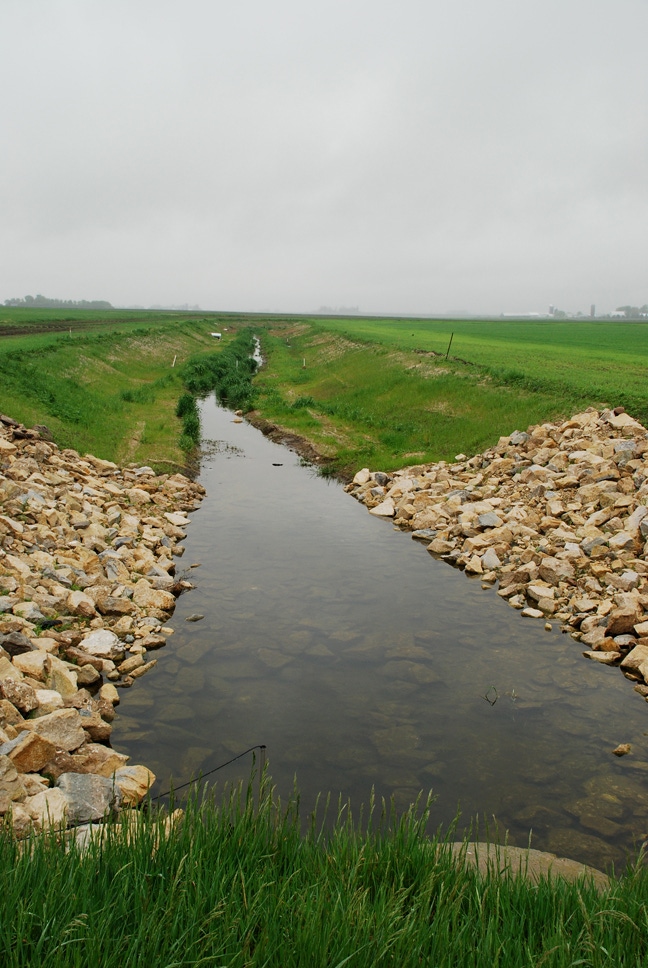October 25, 2010

Kevin Willibey’s ditch copied Mother Nature; her floodplains, that is.
His drainage ditch used to flood over its banks after big rains, loosen its soil, and the banks would collapse into the ditch. The northeastern Indiana grower, along with engineers and the Nature Conservancy, has tested a new ditch design with more gradual sloping sides that mimic a natural floodplain (see related gallery).
This new gold standard in drainage ditches has evolved over 10 years. As ditch water spendsmore time in contact with rocks, vegetation and native grasses on ditch banks, nutrients and sediment adhere to vegetation instead of flowing downstream. The changes in the floodplain provide optimum environment for micro-organisms that do the denitrification.
“This removes the amount of sediment and nutrients contaminating watersheds, and ultimately, the Gulf of Mexico,” says University of Minnesota Bioproducts and Biosystems Engineer Bruce Wilson. “These are very popular in Ohio. There are several in Michigan and Indiana; and there are two or three in Minnesota.”
The two-stage ditch design is more stable, he says. “One cause of conventional ditch failure is water flow impinging on the toe of ditch banks and seepage forces through bank walls. The two-stage design has perforated tile lines that empty field waterthrough side inlets in the ditch at a more stable place.”
Wilson collaborated on a two-stage ditch project near Adams in southern Minnesota, along with the Minnesota Pollution Control Agency and the Mower County Soil and Water Conservation Board. It was funded by an EQIP grant and private donations from Cargill, General Mills and others.
Two-stage approach becoming accepted
“This is a low-tech, common-sense approach that is becoming accepted practice in the Midwest,” says ditch project manager Rich Biske, The Nature Conservancy, Preston, MN. Water probes automatically monitor water quality.
Indiana grower Kevin Willibey doesn’t think his stream “will ever get out of its banks again or erode our fields; it will stay where it is. After the last big rain, the ditch functioned just how it was meant to: The water spread out and flowed nice and easy. And it will be low-maintenance.
“Widening the ditch for the new design took about 10 ft. of ground, but it’s the right thing to do. That’s pretty obvious if you see the before and after.”
Actually, the two-stage ditch style occupies the same amount of land as conventional ones because the width of the buffer strip now lies within instead of outside the ditch, says Biske.
“As we change the landscape to accommodate straight property lines – more farming, more roads and more parking lots – we change how water moves across our landscape, asking a lot of our ditches,” says Chad Watts, project manager for The Nature Conservancy Wabash Rivers initiative,Winamac, IN.“In the name of predictability, dry basements and convenience, we move water more quickly through the conventional ditch system, eroding ditch banks. A two-stage ditch widens the stream channel to spread more water more slowly during floods.
“We’re on the early part of the adoption curve of what we hope is much wider scale adoption of two-stage ditches. And, people realize how much more onerous future government regulations might be if we don’t improve water quality on our own,” Watts says.
Biske adds, “We want to balance productive, profitable farms so important to our landscape; and nutrient and sediment loss, flooding and stress on aquatic diversity.”
How it works
“Nature creates floodplains all the time; we are creating them with a two-stage ditch,” says Joe Draper, The Nature Conservancy project director, Upper St. Joseph River, Angola, IN. “It’s much less invasive to aquatic invertebrates, mussels and fish than cleaning out a conventional ditch. Those organisms help maintain water quality.”
Farmer benefits are reduced bank erosion, scouring and flooding; less ditch maintenance; and less nutrient loss.
The slope of a two-stage ditch is one-half to two-thirds of a conventional ditch (represented by the dotted line in this diagram), greatly reducing banks’ shear stress.
The Nature Conservancy, which has spearheaded much of the two-stage ditch experimentation, has documented the following water-quality benefits compared to conventional ditches in Indiana and Michigan sites:
A 14-20% reduction in total nitrogen runoff.
A potential for 300-500% more denitrification as a result of the floodplain bench areas.
A reduced water turbidity and suspended sediment.
Because the two-stage ditch is more stable, it might only need to be maintained every 20 years, if ever, says Draper.
“The two-stage ditch spreads water out across a broader section,” says Chad Watts, Nature Conservancy Wabash Rivers Initiative project manager, Winamac, IN. “This means less water force undercutting ditch banks.
“This design is a valuable conservation tool that needs to be used along with buffer strips, reduced tillage and best management practices,” Watts adds. “There is no one magic bullet.”
To learn more about two-stage ditches and view a related video, visit http://tinyurl.com/2StageDitch.
About the Author(s)
You May Also Like




